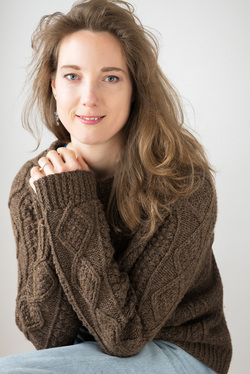Beannaigh Traditional Handkitting

Spring 2023 has been very slow in coming here in the Pacific Northwest. Until early April the snow line was just a hundred feet or so above my home in Issaquah, and nighttime temperatures have frequently been in the 30s. Nevertheless the days are growing longer, the daffodils and cherry blossoms have been blooming in all their glory, and the hardy greens in my garden are flourishing.
This is an important metaphor for me this year. The promise, determination, and growth of this spring is following on the heels of the worst winter of my life. The repeated blows of a serious back injury, a broken hand, the end of a relationship, and an unexpected and unplanned-for move felt like the universe was holding my head underwater. And yet as I'm writing this, I'm looking out the window at a soft and gentle morning, with a new gansey project in my lap and my dog sleeping at my feet, and I'm filled with gratitude and inspiration and hope. Nothing can keep a good farmwife down.
I create historical reproductions of 18th- and 19th-century fishermen's sweaters, faithful copies of family heirloom sweaters, original patterns and knitting kits, and resources for learning the art of gansey and Aran knitting. I just published a new original Aran sweater pattern featuring Celtic-inspired motifs - visit my Store page for your copy!
This is an authentic cottage industry, a home-based small-scale manufacturing business drawing on skills handed down for generations. "Beannaigh" is an Irish word (pronounced BAN-nah), meaning to bless, to honor, or to salute. Handknitting was originally a way for poor women and girls to earn the only extra cash they would see for the year; one elderly woman from the Yorkshire Dales said that as a child, doing some extra knitting "kept the wolf from the door". Another from Ireland referred to her knitting needles as the "four crowbars of poverty".
These are powerful stories for me. When they weren't gutting and packing fish, hauling loads of peat for the fire, and growing their only food themselves, these women knitted. They spent endless hours of winter darkness working by the light of a single candle, if they could afford one, or huddled close to the fire if they couldn't. In spite of their hardships, they created incredibly beautiful patterns and designs that in some cases have remained popular for more than 200 years.
I preserve and pass along the stories of these women with my sweaters, knitting patterns, and classes. The village fishing life of the British Isles has largely disappeared in favor of tourism and larger industries, and their traditional handcrafts have become mere hobby. Thanks to a few dedicated researchers many centuries-old sweater patterns have been recorded, along with the stories of the fishing villages in which they originated and the women who knitted them. Books by Michael Pearson, Mary Wright, Gladys Thompson, and others are still in print and can be found at local bookstores and libraries - take a look at them to learn more!
This is an important metaphor for me this year. The promise, determination, and growth of this spring is following on the heels of the worst winter of my life. The repeated blows of a serious back injury, a broken hand, the end of a relationship, and an unexpected and unplanned-for move felt like the universe was holding my head underwater. And yet as I'm writing this, I'm looking out the window at a soft and gentle morning, with a new gansey project in my lap and my dog sleeping at my feet, and I'm filled with gratitude and inspiration and hope. Nothing can keep a good farmwife down.
I create historical reproductions of 18th- and 19th-century fishermen's sweaters, faithful copies of family heirloom sweaters, original patterns and knitting kits, and resources for learning the art of gansey and Aran knitting. I just published a new original Aran sweater pattern featuring Celtic-inspired motifs - visit my Store page for your copy!
This is an authentic cottage industry, a home-based small-scale manufacturing business drawing on skills handed down for generations. "Beannaigh" is an Irish word (pronounced BAN-nah), meaning to bless, to honor, or to salute. Handknitting was originally a way for poor women and girls to earn the only extra cash they would see for the year; one elderly woman from the Yorkshire Dales said that as a child, doing some extra knitting "kept the wolf from the door". Another from Ireland referred to her knitting needles as the "four crowbars of poverty".
These are powerful stories for me. When they weren't gutting and packing fish, hauling loads of peat for the fire, and growing their only food themselves, these women knitted. They spent endless hours of winter darkness working by the light of a single candle, if they could afford one, or huddled close to the fire if they couldn't. In spite of their hardships, they created incredibly beautiful patterns and designs that in some cases have remained popular for more than 200 years.
I preserve and pass along the stories of these women with my sweaters, knitting patterns, and classes. The village fishing life of the British Isles has largely disappeared in favor of tourism and larger industries, and their traditional handcrafts have become mere hobby. Thanks to a few dedicated researchers many centuries-old sweater patterns have been recorded, along with the stories of the fishing villages in which they originated and the women who knitted them. Books by Michael Pearson, Mary Wright, Gladys Thompson, and others are still in print and can be found at local bookstores and libraries - take a look at them to learn more!
Proudly powered by Weebly